What Is the Ideal Time to Invest in Mid Cap Mutual Funds?

Since the beginning of 2018, the markets have been extremely volatile on the back of global cues. Trade wars, the steep rise in global crude prices, the likelihood of a currency war have all weighed on the markets. Surprisingly, the Nifty index has continued to give positive returns but the real pain has been felt by the mid caps. While the Nifty is up by 4.8% since January, it is the mid-cap index that has lost close to 15% since the beginning of the year. While oil and rupee are one side of the story, there were also concerns of overvaluation in mid caps after most mid caps started quoting at a huge premium to the larger names. The comparative chart below captures the tale of two indices vividly.

Data Source: NSE
With the Nifty Mid Cap index deep in the red, it brings us back to the fundamental question; Is it time to buy into mid cap funds or is it more advisable to stay out of mid cap funds for the time being?

While one will have to be cautious about individual mid cap stocks due to the shifting dynamics, buying mid cap funds with a consistent performance may be an idea to seriously consider. The combination of steep price damage and professional fund management in a mutual fund could create a case for buying into mid cap funds. Here is why.
Price fall has been much steeper than the index revealsThe good thing about mid cap is that it is not exactly a homogenous group of companies. But that is also the reason why the performance of mid caps within the mid cap universe has been so diverse and varied. While the overall mid cap index may have fallen by just about 15% since the beginning of the year, individual stocks have correctly in the range of 30% to 70%. Of course, not all these stocks are going to be value buys but it is surely time to nibble on quality. That is where a fund manager can, perhaps, do a better job. Also, when you buy mid cap funds at the current levels, you are virtually getting specific stocks at 30-70% below their peak prices. At an individual level, that also makes valuations attractive.
A good deal of correction happened due to SEBI reclassificationRecently, SEBI had made some key announcements pertaining to the reclassification of mutual funds into very specific categories for simplicity and ease of comparison. For example, a large cap fund had to be invested in large caps above the threshold of 65%. Similarly, SEBI changed the way mid caps were defined and that resulted in a more standardized classification. Mid caps and small caps were determined based on market cap rankings and therefore they became more of a relative measure compared to an absolute measure. This led to a lot of mutual funds being forced to sell out of their mid cap holdings in order to maintain their original classifications. That was partially responsible for the sell-off in the mid caps. One also cannot forget the capital gains effect. Large investors who were sitting on book profits in mid caps decided to cash the profits ahead of March 31st to avoid the 10% payable on long term capital gains (LTCG). These two factors were largely responsible for the selling pressure, which is more or less behind the market.
Worst in terms of macro risks may be overTwo of the big macro risks for mid caps may be close to bottoming out. First is crude oil. Since the oil price peak of 2014, one of the big beneficiaries of the oil price fall was the mid and small cap companies in India. The dividends of cheap oil directly flowed to them in the form of lower costs. That situation changed since mid-2017 when Brent Crude rallied by more than 70%. That has added a huge input cost pressure on these mid caps. However, with OPEC also promising to hike output and the US pumping at full capacity, the oil price problem may not really worsen from here. Once oil becomes a more manageable problem, the rupee fears should also taper. The RBI has also shown determination to defend the INR at around 69/$ and that should be good news for mid-caps.
To sum it up, the sharp correction in individual mid caps may be making a sound case for buying mid cap funds at this point in time. Of course, the volatility will continue for a couple of more months and hence it would be best to adopt a systematic and phased approach to investing mid cap funds. Mid-cap SIP may be the answer to long term value!
Disclaimer: The information contained in this post is for general information purposes only. IIFL Finance Limited (including its associates and affiliates) ("the Company") assumes no liability or responsibility for any errors or omissions in the contents of this post and under no circumstances shall the Company be liable for any damage, loss, injury or disappointment etc. suffered by any reader. All information in this post is provided "as is", with no guarantee of completeness, accuracy, timeliness or of the results etc. obtained from the use of this information, and without warranty of any kind, express or implied, including, but not limited to warranties of performance, merchantability and fitness for a particular purpose. Given the changing nature of laws, rules and regulations, there may be delays, omissions or inaccuracies in the information contained in this post. The information on this post is provided with the understanding that the Company is not herein engaged in rendering legal, accounting, tax, or other professional advice and services. As such, it should not be used as a substitute for consultation with professional accounting, tax, legal or other competent advisers. This post may contain views and opinions which are those of the authors and do not necessarily reflect the official policy or position of any other agency or organization. This post may also contain links to external websites that are not provided or maintained by or in any way affiliated with the Company and the Company does not guarantee the accuracy, relevance, timeliness, or completeness of any information on these external websites. Any/ all (Gold/ Personal/ Business) loan product specifications and information that maybe stated in this post are subject to change from time to time, readers are advised to reach out to the Company for current specifications of the said (Gold/ Personal/ Business) loan.



